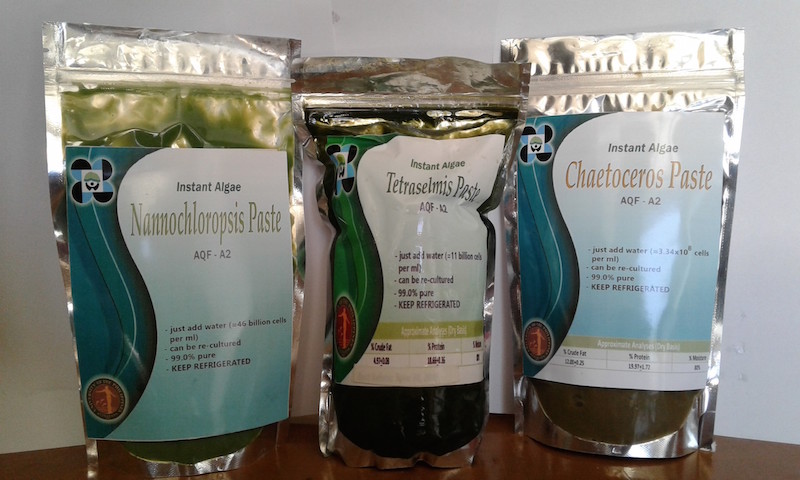
Products
Nutrition & Feed products
Philippine researchers develop affordable microalgae paste
The strains that the researchers have produced include Tetraselmis sp., Chaetoceros calcitrans, Nannochloropsis sp. and Chlorella vulgaris, all in paste form, according to Soledad Garibay, project head for UPV-CFOS Improvement of Microalgae Paste Production for Aquaculture.
July 11, 2017 By Ruby Gonzalez
 Affordable larvae feed for local hatcheries has been developed in the Philippines through the collaboration of a state university and government agencies.
Affordable larvae feed for local hatcheries has been developed in the Philippines through the collaboration of a state university and government agencies.The algal paste is available at about P1,500 ($30) a kilo (see sidebar) and it is now being tested in private milkfish and shrimp hatcheries in the Philippines. At the present time UPV can produce 60 liters of paste per production period of 10 days.
The commercially available brands are all imported. The cost, between $100 to 150 a kilo, is more expensive owing to logistics charges such as shipment and customs processing fees. These processes also cause extended time for delivery.
“Algal paste is considered the best alternative to live microalgae during difficult times of
production,” Garibay said. “Algal paste can be readily used any time. Based on our research studies, the algal paste can be refrigerated for three months and yet still retain its viability.”
“Its cultivation is usually dependent on natural illumination and ambient temperature,” she said “However, these days, light and temperature parameters have become unpredictable because of climate change. Hence, dry and rainy months are no longer distinct. Such a scenario for [outdoor] microalgae production is not sustainable.” The Philippines has two marked seasons: dry and wet. Wet season usually extends from June to November.
While microalgae paste is not new, it seems that Philippine hatcheries are still in a wait-and-see stance with regard to this locally produced paste.
“Industries are open to the possibilities of using paste in hatcheries but they want first to see if the technology will really work. So the pilot-testing activities of UPV will validate our claims for the product,” she said.
Improvement/enhancement of product shelf-life and nutritional quality are on-going.
“With the algal paste, our local industry can be provided with an efficient and readily available larval food. However, further refinements are necessary for the algal paste to be fully utilized by the industry in providing cost-efficiencies in aquaculture,” Garibay said.
The collaborative effort to produce the microalgae included researchers from the University of the Philippines Visayas, College of Fisheries and Ocean Sciences and the Department of Science and Technology and the Philippine Council for Agriculture, Aquatic and Natural Resources Research and Development (DOST-PCAARRD).
— Ruby Gonzalez
The four algae species
- Tetraselmis sp is relatively large and widely cultured in aquaculture facilities as an important feed for finfish and crustaceans.
- Nannochloropsis sp, is a marine alga known to grow fast and is easy to culture in tanks.
- Chaetoceros sp. a diatom, is also an essential food source in the rearing of all stages of marine bivalve molluscs (clams, oysters, scallops), the larval stages of some marine gastropods (abalone, conch), larvae of several marine fish species and penaeid shrimp, and zooplankton (FAO).
• Chlorella vulgaris is a eukaryotic, unicellular green algae that thrives in freshwater; it’s spherical in shape.
Source: S. Garibay, College of Fisheries and Ocean Sciences, University of the Philippines – Visayas
Print this page
Advertisement
- Aquaculture to share in £10m plan to commercialize research findings
- First out-of-season reproduction of beluga sturgeon





